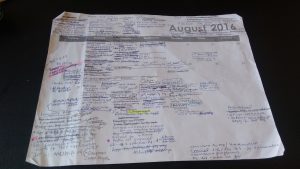Thomas Couser, Sidonie Smith and Julia Watson, and Gillian Whitlock all remind us that life narratives are commodities that circulate in the global literary marketplace. In that marketplace, these scholars note, some kinds of stories and some kinds of subjects will sell, or can be made to sell. Others can’t or won’t, and we should think about the voices, experiences, and stories that are missing from or fail in the market. Best-sellers and literary failures help us understand the values and expectations of consumers, particularly consumers in the West, and how the market for life narratives can conform to or resist those values and expectations.
To understand these ideas, we have to think about how what we consume is shaped for us: we don’t read in a vacuum. (To get a sense of the network of writers, companies, media, and readers involved in a book’s publication and reception, check out this listicle.) In “Introduction: Word Made Flesh,” Whitlock argues we need to pay attention to the “material processes” of “production, transmission, and reception of autobiographical texts” (14). In particular, she asks us to attend to the “features that surround and cover the text,” what Gerard Genette calls the paratext. There are two aspects of paratext: the peritext (“the covers, introductions, acknowledgements, dedications, blurbs”) and the epitext (“the elements ouside of the bound volume,” including “reviews and criticism across various mass media, movements of the celebrity circuit; the book prizes and the calendar of literary festivals”). When we read paratext, Whitlock suggests we read with these questions in mind:
Who is getting to speak autobiographically, how, and why? To what effect? What becomes a best-seller, and what is remaindered or republished? How do these solicit our attention? What kinds of engagement come into play? How do these appeal to readers, and what kind of consumers are we asked to become? (14)
(For more on paratext, see Smith and Watson 99-102.)
In your next blog post, choose one of our life narratives that you did not write about for the genre analysis, and write an analysis based on EITHER option a or b, below. As you write, think about Whitlock’s questions (as well as your own), as you consider the implications of what you’re observing in these aspects of marketing. Talk about the significance of what you observe, what it helps us to better understand.
- Option A Examine peritext: analyse the jacket design, including the cover image(s), the typeface, whose name(s) are prominent, the book review blurbs on the back and on the first pages of the book, etc. (You’ll need to be able to see these, so that might affect your choice of text.)
- Option B Examine epitext: Select 3 reviews of the book (e.g., on Amazon, Goodreads, or publisher sites), and identify patterns in them that suggest how the life narrative and the life narrator are being read by consumers.
Remember to follow ethical research practices and good blogging design in your use of links, reporting expressions, and citations.
Posts are due Friday at noon, and comments by Monday noon.

